Hydrocarbon Polymer Electrolytes for Fuel Cell Applications - Softcover

Zu dieser ISBN ist aktuell kein Angebot verfügbar.
Alle Exemplare der Ausgabe mit dieser ISBN anzeigen:
Reseña del editor:
Direct methanol fuel cells (DMFCs), employing liquid methanol as a fuel, offer an attractive option in portable devices due to their simplicity in the system structure (easy storage and supply), no need for fuel reforming or humidification. For obtaining a higher power density, the membranes that show high proton conductivity, and at the same time, low methanol permeability are strongly desired. However, there is achieved only a little progress because of trade-off relations between these parameters. Also the membrane stability, particular to hydrolytic and chemical stability is recognised as a key factor that affects fuel cell performances. In the authors' recent work, they have been working on the design and the development of new families of cost-effective, readily prepared proton-conducting membranes based on chemically cross-linked PVA-PAMPS [poly(vinyl alcohol) and poly(2-acrylamido-2-methyl-1-propanesulfonic acid)] composites. The authors have first introduced new concepts of secondary polymer chains such as "binary chemical cross-linking" or "hydrophobiciser" and the "stabiliser"effect. Also, the authors have established a new concept of PVA-PAMPS based semi-interpenetrating polymer networks (semi-IPNs) by incorporating plasticizer variants R (R = poly(ethylene glycol)(PEG), poly(ethylene glycol) methyl ether (PEGME), poly(ethylene glycol) dimethyl ether (PEGDE), poly(ethylene glycol) diglycidyl ether (PEGDCE)) and poly(ethylene glycol)bis(carboxymethyl)ether (PEGBCME) as the third components. Incorporation of the above concepts promoted not only the high proton conductivity , flexibility with low methanol permeability (1/3 - 1/2 of Nafion 117 membrane), but also the excellent hydrolytic and the oxidative stability of PVA-PAMPS composites. The membrane electrode assembly (MEA) fabricated with PVA-PAMPS composites has been successfully established, which showed the similar open circuit voltage (OCV) to that of Nafion 115, and a power density 52 mW cm-2 at 80oC. A striking feature of the long-term test was that no appreciable decay of the current density was observed during the whole operation time longer than 130 hours at 50oC, and so was the power density. This book is the first time that such long-term operation of DMFC was reported since PVA-PAMPS composite are all hydrocarbon membranes made simply of aliphatic skeletons. They are very different from the perfluorosulfonic membranes such as Nafion, or other reported membranes with aromatic skeletons. Therefore this affords the PVA-PAMPS composites unique structure compared to most of the proposed membranes, which suggests the good candidacy of PVA-PAMPS composites when they are intended for use in low temperature DMFCs.
„Über diesen Titel“ kann sich auf eine andere Ausgabe dieses Titels beziehen.
- VerlagNova Science Publishers Inc
- Erscheinungsdatum2008
- ISBN 10 1604568461
- ISBN 13 9781604568462
- EinbandTapa blanda
- Auflage1
- Anzahl der Seiten73
EUR 0,92
Versand:
EUR 5,63
Von Vereinigtes Königreich nach USA
Beste Suchergebnisse beim ZVAB
Hydrocarbon Polymer Electrolytes for Fuel Cell Applications
Verlag:
Nova Science Pub Inc
(2008)
ISBN 10: 1604568461
ISBN 13: 9781604568462
Gebraucht
Paperback
Anzahl: 1
Anbieter:
Bewertung
Buchbeschreibung Paperback. Zustand: Very Good. The book has been read, but is in excellent condition. Pages are intact and not marred by notes or highlighting. The spine remains undamaged. Artikel-Nr. GOR012596383
Weitere Informationen zu diesem Verkäufer | Verkäufer kontaktieren
Gebraucht kaufen
EUR 0,92
Währung umrechnen

